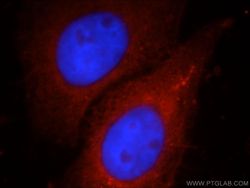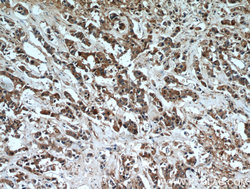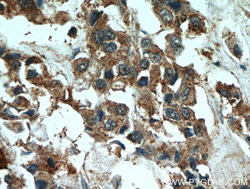Antibody data
- Antibody Data
- Antigen structure
- References [9]
- Comments [0]
- Validations
- Western blot [1]
- Immunocytochemistry [1]
- Immunohistochemistry [2]
Submit
Validation data
Reference
Comment
Report error
- Product number
- 21319-1-AP - Provider product page

- Provider
- Proteintech Group
- Proper citation
- Proteintech Cat#21319-1-AP, RRID:AB_10733644
- Product name
- GTSE1 antibody
- Antibody type
- Polyclonal
- Description
- KD/KO validated GTSE1 antibody (Cat. #21319-1-AP) is a rabbit polyclonal antibody that shows reactivity with human, mouse, rat and has been validated for the following applications: IHC, WB, ELISA.
- Reactivity
- Human, Mouse, Rat
- Host
- Rabbit
- Conjugate
- Unconjugated
- Isotype
- IgG
- Vial size
- 20ul, 150ul
Submitted references G2 and S phase-expressed-1 induces chromosomal instability in esophageal squamous cell carcinoma cells and inhibits cell apoptosis through ROS/JNK signaling.
GTSE1 promotes tumor growth and metastasis by attenuating of KLF4 expression in clear cell renal cell carcinoma.
GTSE1 promotes prostate cancer cell proliferation via the SP1/FOXM1 signaling pathway.
G2 and S phase-expressed-1 acts as a putative tumor promoter in cervical cancer by enhancing Wnt/β-catenin signaling via modulation of GSK-3β.
lncRNA LINC00665 Stabilized by TAF15 Impeded the Malignant Biological Behaviors of Glioma Cells via STAU1-Mediated mRNA Degradation.
GTSE1 is involved in breast cancer progression in p53 mutation-dependent manner.
High G2 and S-phase expressed 1 expression promotes acral melanoma progression and correlates with poor clinical prognosis.
Expression profiling of small intestinal neuroendocrine tumors identifies subgroups with clinical relevance, prognostic markers and therapeutic targets.
Silencing GTSE-1 expression inhibits proliferation and invasion of hepatocellular carcinoma cells.
Zhang M, Wang X, Liu C, Zheng Z, Wan J, Yang Y, Chen S, Liu H
Molecular carcinogenesis 2023 Feb;62(2):122-134
Molecular carcinogenesis 2023 Feb;62(2):122-134
GTSE1 promotes tumor growth and metastasis by attenuating of KLF4 expression in clear cell renal cell carcinoma.
Chen W, Wang H, Lu Y, Huang Y, Xuan Y, Li X, Guo T, Wang C, Lai D, Wu S, Zhao W, Mai H, Li H, Wang B, Ma X, Zhang X
Laboratory investigation; a journal of technical methods and pathology 2022 Sep;102(9):1011-1022
Laboratory investigation; a journal of technical methods and pathology 2022 Sep;102(9):1011-1022
GTSE1 promotes prostate cancer cell proliferation via the SP1/FOXM1 signaling pathway.
Lai W, Zhu W, Li X, Han Y, Wang Y, Leng Q, Li M, Wen X
Laboratory investigation; a journal of technical methods and pathology 2021 May;101(5):554-563
Laboratory investigation; a journal of technical methods and pathology 2021 May;101(5):554-563
G2 and S phase-expressed-1 acts as a putative tumor promoter in cervical cancer by enhancing Wnt/β-catenin signaling via modulation of GSK-3β.
Guo W, Zhu J, Zhu Y, Wang K
Environmental toxicology 2021 Aug;36(8):1628-1639
Environmental toxicology 2021 Aug;36(8):1628-1639
lncRNA LINC00665 Stabilized by TAF15 Impeded the Malignant Biological Behaviors of Glioma Cells via STAU1-Mediated mRNA Degradation.
Ruan X, Zheng J, Liu X, Liu Y, Liu L, Ma J, He Q, Yang C, Wang D, Cai H, Li Z, Liu J, Xue Y
Molecular therapy. Nucleic acids 2020 Jun 5;20:823-840
Molecular therapy. Nucleic acids 2020 Jun 5;20:823-840
GTSE1 is involved in breast cancer progression in p53 mutation-dependent manner.
Lin F, Xie YJ, Zhang XK, Huang TJ, Xu HF, Mei Y, Liang H, Hu H, Lin ST, Luo FF, Lang YH, Peng LX, Qian CN, Huang BJ
Journal of experimental & clinical cancer research : CR 2019 Apr 8;38(1):152
Journal of experimental & clinical cancer research : CR 2019 Apr 8;38(1):152
High G2 and S-phase expressed 1 expression promotes acral melanoma progression and correlates with poor clinical prognosis.
Xu T, Ma M, Chi Z, Si L, Sheng X, Cui C, Dai J, Yu S, Yan J, Yu H, Wu X, Tang H, Yu J, Kong Y, Guo J
Cancer science 2018 Jun;109(6):1787-1798
Cancer science 2018 Jun;109(6):1787-1798
Expression profiling of small intestinal neuroendocrine tumors identifies subgroups with clinical relevance, prognostic markers and therapeutic targets.
Andersson E, Arvidsson Y, Swärd C, Hofving T, Wängberg B, Kristiansson E, Nilsson O
Modern pathology : an official journal of the United States and Canadian Academy of Pathology, Inc 2016 Jun;29(6):616-29
Modern pathology : an official journal of the United States and Canadian Academy of Pathology, Inc 2016 Jun;29(6):616-29
Silencing GTSE-1 expression inhibits proliferation and invasion of hepatocellular carcinoma cells.
Guo L, Zhang S, Zhang B, Chen W, Li X, Zhang W, Zhou C, Zhang J, Ren N, Ye Q
Cell biology and toxicology 2016 Aug;32(4):263-74
Cell biology and toxicology 2016 Aug;32(4):263-74
No comments: Submit comment
Supportive validation
- Submitted by
- Proteintech Group (provider)
- Main image

- Experimental details
- L02 cells were subjected to SDS PAGE followed by western blot with 21319-1-AP(GTSE1 antibody) at dilution of 1:300
- Sample type
- cell line
Supportive validation
- Submitted by
- Proteintech Group (provider)
- Main image

- Experimental details
- Immunofluorescent analysis of HepG2 cells, using GTSE1 antibody 21319-1-AP at 1:25 dilution and Rhodamine-labeled goat anti-rabbit IgG (red). Blue pseudocolor = DAPI (fluorescent DNA dye).
- Sample type
- cell line
Supportive validation
- Submitted by
- Proteintech Group (provider)
- Main image

- Experimental details
- Immunohistochemical of paraffin-embedded human breast cancer using 21319-1-AP(GTSE1 antibody) at dilution of 1:50 (under 10x lens)
- Sample type
- tissue
- Submitted by
- Proteintech Group (provider)
- Main image

- Experimental details
- Immunohistochemical of paraffin-embedded human breast cancer using 21319-1-AP(GTSE1 antibody) at dilution of 1:50 (under 40x lens)
- Sample type
- tissue
 Explore
Explore Validate
Validate Learn
Learn Western blot
Western blot ELISA
ELISA